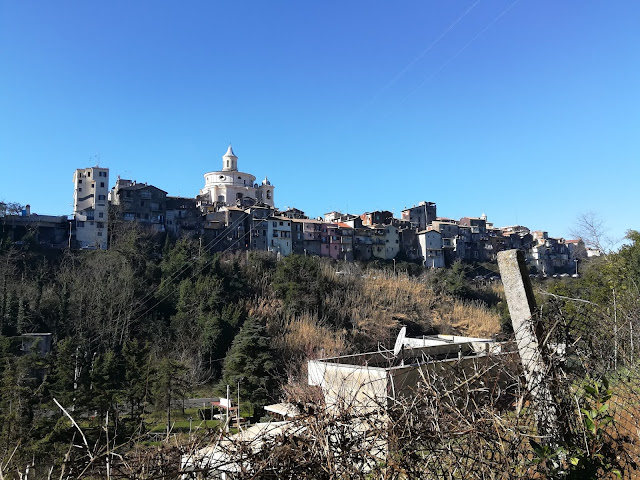On a nice February weekend, my brother and I decided to take a day trip from Rome and visit a few small towns just east of the capital. We took a train and reached the station of Zagarolo where we started our hike uphill from there. Our first stop was the small town of Zagarolo, just a few kilometers from the station. Built on top of a tufaceous hill it features an elongated old town running atop the hill. As we reached the city center we first came across the large Palazzo Rospigliosi, once a castle belonging to the Colonna family, it was later transformed into a palace during the 16th century and decorated by famous artists of the time. The interior even features references to the battle of Lepanto as the Colonna family was one of its main representatives during that conflict. From the Colonna family, it then passed over to the Rospigliosi family which held it until the city became its owner after the second world war. It now holds the toy museum which we decided not to visit as we still had much to see. From the palace, we then continued through the old town and reached the large church of San Pietro with a beautiful baroque cupola and interior. Onwards we then reached the central square by a beautiful scenic building made up of dark tufaceous stone. Built in the 17th century it featured some interesting figures on its facade and is now used as the town hall. On the other side of the square stands the church of San Lorenzo with a nice baroque interior. After reaching the end of the town we turned back and walked back through the city center until we reached the large Piazza Santa Maria with a baroque fountain at its center. Here we turned left and walked in the direction of our next stop: Palestrina. After walking through a nice open countryside we then came in sight of the first houses of the town and not long after reached the central Piazza Regina Margherita. Here we first visited the Cathedral of Sant'Agapito featuring a nice Romanesque exterior; the interior had been remade during the 19th century in Neoclassical style. Back in the square we then admired the facade of the palazzo del Seminario which was built over the ancient Roman basilica that faced the forum, now the town's square. Traces of its ancient past are visible on both the facade and below the square to the side. As we continued onwards we started our ascent of the city, which is built on the slope of the Monte Ginestro. As we walked up the terraced streets we came upon the church of Sant'Antonio Abate, which featured a nice baroque interior. Then a few more turns uphill we finally reached the large Palazzo Colonna Barberini where the archaeological museum is located. This incredible palace originally built during the 11th century was refurbished during the 15th and 16th centuries to take its current baroque circular form. It was built on top of the ancient Temple of Fortuna Primigenia which covered the whole side of the mountain, going from where the palace is located on the top, all the way down to where the forum, now the main square, is located. That explained the terraced streets we were walking on our way up. We decided to head inside the museum, and after purchasing the ticket, started to explore the nice exhibition. The objects inside came mostly from the temple itself or the surrounding necropolises and featured some interesting pieces. The highlight of the museum was the Nile Mosaic, a late Hellenistic floor mosaic from the 1st century B.C. depicting the Nile river and scenes with Ptolemaic Greeks, Aethiopians in hunting scenes, and various animals. Its large size, 5.85 meters to 4.31 meters, and beautiful details make it an extraordinary piece and provide a glimpse into the Roman fascination with ancient Egyptian exoticism. After visiting the museum we then headed out and across the street to see the ruins of the terraced part of the temple which had a beautiful open view towards the town below and the landscape all around. Here we explored the traces of elegant columns, decorated niches, and bases of altars. Once we had seen enough, we headed back up the terraces and from the museum took a trail heading up to the top of Monte Ginestro. As we reached the top we came in sight of the small town of Castel San Pietro Romano, part of the club the most beautiful villages in Italy. This small town which dominates the Valle del Sacco, a nice valley extending from east to west just below Palestrina, holds a small yet interesting historic center. We walked through its pretty streets, stopping to have a look at the church of St Peter, built in the Baroque style. Then we visited the Rocca, the castle built by the Colonna family to rule over these lands. The view from the top was incredible: on one side the valley below and on the other the Prenestini mountains. This was also a great moment to admire the view as the sun was starting to set, giving the entire setting a golden hue. We then decided it was time to head back, so we retraced our steps following the trail that lead us back through Palestrina and then out through the southern city gate. We walked through the countryside as it started to get dark and manage to reach the train station of Zagarolo from where we took our ride back to Rome.




























